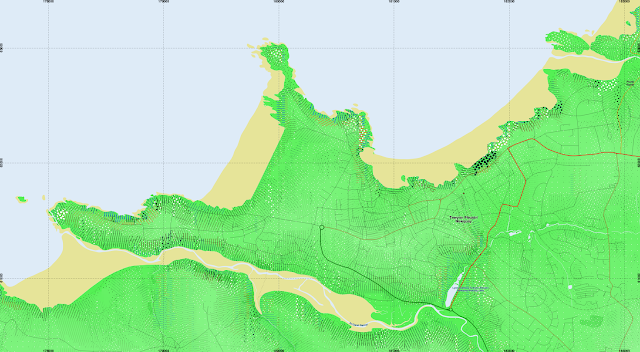I realised the first step was to create a way of using a list of the images of the ground reference points and their coordinates, to examine the images together with remote-sensed images.
I've made a Python program that takes in a list of image file names and their latitude and longitude co-ordinates from a csv file, and uses these to make a subset of an area of a Landsat image 3km x 3km, and display a spectrum of a smaller area around the point. I presently use an area of 120m x 120m which is 4x4 Landsat pixels.
The code expects a layerstacked image of the optical and near-infrared bands, of which there are 6 for Landsat 7, and 7 for Landsat 8.
It will convert the lat/long coordinates, to OSGB grid references for labelling, and if specified to projected UTM coordinates which the Landsat images are released in.
The output below uses a Landsat 8 image in UTM30N, it is labelled in OSGB, I believe UTM30N grid north is fairly close to OSGB36.
Starting with a few of the pictures from the MSc fieldtrips I mentioned:
The images below are from Landsat 8 in July 2014, with the fieldtrips in Feb/March 2014. The versions in the Google+ album below are from Landsat 7 data from March 2007.
There is a little caveat I will make that certain of the ground level pictures are looking at a point a distance away from the coordinates that are where the photographer was standing.
Also the GPS sometimes made catastrophic errors, and occasionally I have manually edited the coordinates by taking an average of other pictures at the same site (within a small area).
Update:
The code is now available on my Bitbucket account. It only works on Linux and is likely to still be a bit rough and ready at the time of writing.I have also uploaded the output of the fieldwork ground reference points as a Google+ album.
 |
| On the Penglais campus at the back entrance of the Llandinam building. |
 |
| Ynyslas dunes near Borth |
 | |
| Foreshore |
 |
| Borth Bog |
 |
| An area of decidious woodland near Tal y Bont |
 |
| Some upland grassland with Dr Pete Bunting |
 | ||
| Vaccinium near Nant y Arian |
 |
| Dead larch |
 |
| Looking west, towards Taylor's Leat, an ingenious method of providing water to drive a wheel to power mining machinery in the 19th century. |
 | |
| Next to Nant y Moch reservoir dam |


























